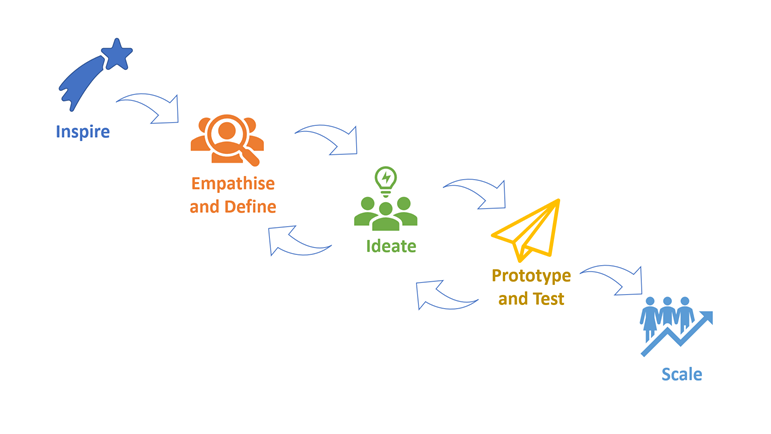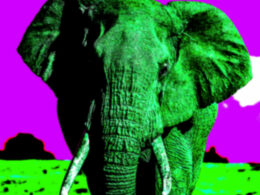Design thinking is at its best when both the problem and the solutions are not very well defined, and when there is a significant involvement of human emotions. The present situation is a perfect storm for the application of creativity.
If necessity begets invention, we can’t have a more important and urgent occasion to innovate, not just the life-saving medicines and equipment, but also the means of economic and social revival. The COVID-19 induced pandemic and ensuing lockdown offers a unique and ironical situation to apply some fresh thinking, as to how economies can get back to speed with minimum loss of lives and time.
A disciplined, human-centric approach is not just needed for nations, but also for firms, both large and small, which together pull up the economy. In this piece, I would like to call out three salient aspects of design thinking, which would help business leaders turn the adversary into their favor and to not miss out on this perfect storm.
But before that, let’s have a look at the Design Thinking process.

The design thinking process comprises of the following five stages:
- Inspire: Creating a stretched goal on what is to be achieved, and why to adopt design thinking
- Empathize and Define: Understanding the real issues from customers’ perspective and prioritize the problems/ opportunities worth going after (here customer refers to anybody whose problem you wish to solve)
- Ideate: Generate a high quantity of potential idea that can possibly address the problem/ opportunity
- Prototype and Test: In an iterative fashion, you create mock-ups of your promising concepts and get those validated by real customers
- Scale: The validated concepts are then taken to their logical conclusion, so as to address the problem/ opportunity initially identified.
A very unique aspect of design thinking is the stretch to achieve a balance between Human Desirability, Business Viability, and Technical Feasibility. Unlike traditional approaches of creative problem solving, where there is often a trade-off between what’s good for the customer and what’s profitable for the company, design thinking strives to strike a balance between all three aspects, and, hence, aims at a global optima.

Further, the entire process is iterative, human centered, and rapid, whereby taking away guesswork from the otherwise nebulous process of problem solving.
As for the tenets of design thinking, the important ones are:
- Design thinking is not about design, as much as about thinking
- Focus on the subject, and not the object
- Not every problem is worth solving, and that not every problem can be solved
- Solve the problem with the customer and not for the customer
- Think with your hand
- Fail often to succeed sooner
- Develop an experimental mindset
- It’s not about what else, it’s rather about what less
- Be an integrative thinker (divergent + convergent)
- Visualize your thinking
For an effective application of design thinking, one must develop competence around all the three dimensions of learning — Toolsets, Skillsets, and Mindset. Think of Toolsets as the techniques, frameworks, methods, and instruments to diagnose a problem, or generate ideas, or validate those ideas. Skillsets indicate how adept somebody is in utilizing those tools to truly empathize with a customer, or manage group dynamics during brainstorming session, or frame the validated solutions for scaling. Finally, and most importantly, the appropriate Mindset denotes the thinking paradigms that act as the scaffolding on which rests the tools and skills. An appropriate mindset for the empathy stage would be to park your judgement, and show genuine interest in customers’ context and unspoken words.

Together, the Toolsets, Skillsets, and Mindset denote the What, How, and Why of design thinking, respectively.
As you would appreciate, the most convenient is to pick up the toolsets, and, with practice, one can even develop skillsets, but unless one cultivates endearing mindset, an earnest application of design thinking would be elusive.
Another very relevant question is — Is design thinking applicable to all sorts of problems?
While the tenets of design thinking are handy in any context, there are certain problems which are best suited to be addressed with design thinking than others.

As shown in the figure above, design thinking is best suited when both the problem space and solution domain are ill-defined and not fully understood. I discuss in detail, by offering relevant examples, of the contexts in which the other approaches, namely Critical Thinking, Lean Thinking, and Lateral Thinking, come in handy, and what’s the sweet spot for design thinking.
For the time being, it must suffice that a problem with high degree of ambiguity and involvement of human emotions is a good candidate for applying design thinking. The present pandemic offers just the appropriate context.
So, after this brief discourse on the essentials of design thinking, let me draw your attention back to how business leaders can borrow some of the tenets and practices of design thinking to elegantly manage the current crisis.
Harness empathy to cultivate an ecosystem
Individual organisms are vulnerable to shocks, but ecosystems not only survive, but often thrive amid catastrophes — that’s what Charles Darwin told us. While organizations are often fragile, ecosystems are antifragile, to borrow a term from Nassim Taleb.
An ecosystem comprises of your customers, suppliers, complementors, substitutes, competitors, regulators, and other agencies, which together, have a positive reinforcement effect on the performance and longevity of the complex whole. Think of how the diamond cluster in Surat, or the leather ecosystem in Kanpur has survived for so long, though the leadership often changes hands.
The current pandemic is a good opportunity to think of, understand and engage with the disparate players in the ecosystem and create something more robust, which benefits your end customers and builds a win-win for all the parties involved.
Take for instance how India’s biggest online grocery delivery platform, Bigbasket, is collaborating in an unprecedented way with FMCG companies, human resource agencies, cab aggregators and other players to honor customer commitments. Bigbasket partnered with Uber to deliver essentials across various part of India, have resorted to non-conventional forms of hiring to keep up with their demand, how it’s leveraging the expertise of its investment partner Alibaba, expanding its range through inorganic means, and engaging in sensitization drives.
Reframe the competitive dynamics
A natural consequence of an ecosystem outlook is to think more on the lines of collaboration than competition. There are three prime possibilities during recessionary times: 1) acquire distressed assets, 2) reconfigure business models, and 3) adopt lean like never before.
Acquire distress assets
A bad time can turn assets into liabilities and liabilities into assets, as demonstrated by the tango between Amazon and Barnes & Noble’s in the US book selling market. Barnes & Nobles’ biggest strengths in terms of collection, brand, locations, captive customer base, favorable contracts with publishers, and legacy, all came in the way of the company going online. And all the liabilities of Amazon turned out to be the assets in the dotcom era. The 2000 bubble burst was a wake-up call for both, and since then, their fortunes have only forked out, with Barnes and Nobles’ slipping into the Bankruptcy Stocks to Watch list, as the company got sold to a hedge fund — Elliott Advisors.
In the current COVID-19 induced pandemic, China is on a shopping spree, more recently with the People’s Bank of China raising its stake in India’s highly profitable HDFC Bank. This is the best time to pick up distressed assets, China knows, and so must your business leaders.
What was once your dream target, might come in cheap, and this calls for re-looking at your asset- liability equation more creatively.
Reconfigure business models
India’s Prime Minister, Narendra Modi, said in his recent LinkedIn post “Today, the world is in pursuit of new business models… that are easily adaptable.” Citing the examples of healthcare, e-commerce, and work from home, the PM urges organizations to leverage the power of technology to challenge the conventional ways of creating, delivering and capturing value.
There is no better time for hitting the ‘Reset’, and the most vital reset would be of new business models, which, I believe, is more profound than even a radical product or process innovation. Will sports see an even greater adoption of Virtual Reality and user level gamification? Will home delivery be the dominant model of retail? Will restaurants thrive with just their kitchens? Will universities make online education more mainstream?
During such exigencies pioneers are born — the ones who experiment, tame emerging technologies, and look at capturing new niches.
Adopt lean like never before
The pandemic and ensuing lockdown has made us realize the adaptability of human body and plasticity of human mind. We now know that with a lot less we can survive, both in personal and professional spheres. The lean period is a cleansing cycle, where a lot of waste, fat, unquestioned habits, excess resources are getting pruned, and rightly so. If companies can serve their customers well and continue to add value to their stakeholders with a lot less, that lot less might become a ‘new normal’.
Of course, this pruning will come at a cost. The cost of resources being laid off, plants being scaled down, networks being reconfigured, process looked with a new sense of meanness, but all this will only make the organization antifragile. People will get to their rightful avenues, instead of being perpetually underutilized.
It’s the defeat at the WWII that pushed Japan to adopt lean. Else, there were no world winning Toyota, Sony, or Honda.
Can we do the same for India?
Experiment with ‘Free’
Finally, up the ante on experimentation. When do you experiment more — when you have a lot to loose or very little to loose? I guess that your propensity to experiment goes up radically when you have little to loose. Turn the table on the present times in viewing it as an avenue to experiment judiciously.
One of the useful experiments is to consider free more seriously. While customers, in both B2B and B2C parlance, are tight on their budgets, try using this opportunity to earn some social capital. Instead of trying to make money in every single deal, give it free this time, and you will earn a tremendous amount of goodwill.
Remember, where you learn from isn’t always same as where you earn from.
Here are some examples: Novo Nordisk is offering free insulin to its patients for 90 days, Amazon’s Audible is giving free books for kids during the lockdown, Zoho has made its apps free for coronavirus hit SMEs, Udemy has reduced the course fee to as low as ₹385, etc.
There are a whole host of free entertainment avenues, which can help build some taste. That’s smart thinking.
In summary, you can shape up your life, business, industry and even nation by being more empathetic, courageous, experimentative, and kind during these difficult times and design thinking can just be the panacea.
Do write back with your views.
 DR. PAVAN SONI is Founder and Innovation Evangelist at Inflexion Point Consulting. TEDx speaker. Teacher. Strategy Coach. Creativity Workshops. Executive Education.
DR. PAVAN SONI is Founder and Innovation Evangelist at Inflexion Point Consulting. TEDx speaker. Teacher. Strategy Coach. Creativity Workshops. Executive Education.
This article originally appeared in Medium. Photo by Kari Shea on Unsplash.












